Welcome to Part 1 of the 4 part series Injury Prone or Bad Luck?! We will be taking a deep dive looking to see if we can predict injuries for hitters and pitchers. We will also take a look at some of the more notable names in baseball who are often injured to determine if they are injury-prone or just have bad luck!
In Part 1, we will look to see if it is possible to predict the likelihood of an injury to hitters during a given year.
What inspired this series? Well, it was my own pain and suffering during my fantasy baseball career.
My first ever season in fantasy baseball was in 2013. What if I told you that I had six straight years of my first-round draft pick being on the IL? I could run the names and prove it to you guys, but thinking about those failed teams just makes my heart hurt too much. Please don’t make me relive my horrors, I’m begging you.
It is what it is because injuries are part of the game. With 162 games covering 187 days plus Spring Training, injuries are going to happen. And for whatever reason, it felt like 2019 was littered with injuries. According to Spotrac, the Yankees lost $98,211,905 to the IL! A total of 3,072 days between 30 players were on the IL during the 2019 season alone! The MLB had an unbelievable amount of money on the IL during the past three years (when the 10-Day IL was implemented).
| Year | Salary on the IL | Days lost on the IL |
| 2017 | $609,964,759 | 31,300 |
| 2018 | $745,769,319 | 34,126 |
| 2019 | $785,182,465 | 41,152 |
This is a long roundabout, off-task way of saying that injuries happen. They happen a lot. And they happen to everyone. I would bet the 2019 IL salary total that at some point during your fantasy baseball career, you have had a season derailed by the injury bug. Which gets us to the point of this article. Can we predict injuries? Can we take steps to avoid having our season derailed and ruined?
For hitters, we are going to look at height, weight, BMI, position, and age as our factors. During the research, we only used players who went on the IL. Day-to-day injuries are unavoidable and would be impossible to predict, so they were not included in this article. But before we break down the potential factors causing injuries, we need to talk about the different types of injuries. Now let’s get it!
Boney Issues
I believe that bone injuries are flukes. For example, Willie Calhoun breaking his jaw, Joey Gallo breaking his hamate, and Christian Yelich fracturing his kneecap. All three examples are unpredictable and random. And with young, healthy professional athletes, that is what we should expect. Trying to predict if someone is going to break a bone is impossible, and shouldn’t cause someone to be labeled injury-prone. The nice thing about bone injuries, when they heal, they are usually as strong or stronger than before the injury. So not only are fractures/breaks impossible to predict, but they typically don’t reoccur as we see with muscle issues.
Muscle Issues
When it comes to muscular issues, they tend to be semi-predictable and repeatable. With the 162-game season-long grind, players are at a higher risk for muscular injuries. This could be caused by the lack of built-in recovery days. If you look at the NBA and NFL, those players don’t play nearly as many games and have designated rest days. With 162 games packed into 187 days, the amount of repetitive micro-trauma that players sustain puts MLB players at enhanced risk for developing a soft tissue injury. With high-level athletes, all they want to do is compete. It’s their job. So it’s understandable that they would want to get back on the field as quickly as possible, and not allow enough time for their muscles to recover from minor injuries. Rushing back leads to a higher increase in repeated injuries and an increase in severity.
A prime example of muscle injuries being repeatable is Josh Donaldson and his left calf from 2018. After the 2018-2019 off-season, look at what Donaldson was able to do. He went from playing 52 games in 2018 to playing 155 games in 2019 as a 33-year-old in the National League. After he was able to rest and recover from his calf issues, he looked the Donaldson of old.
Some injuries tend to reoccur in general. A specific example is hamstring injuries. For whatever reason, hamstrings do an excellent job of passing all the tests as if they’ve healed. No pain, full strength, but they just seem to be quirky and reoccur more often than others. I’m looking at you, Jeff McNeil. It all comes back to having the players allow the proper time for healing and recovery, decreasing the reoccurrence rate as much as possible.
Ligament Issues
Ligaments are the one injury that is hard to determine if it is predictable or up to chance. If you’re making me pick, I’m going to chicken out and say both. Because ligaments can happen from the most unpredictable movements, Tyler Naquin’s ACL injury last year comes to mind. Or, we could have a ligament injury that we can see coming from a mile away. Enter Chris Sale, 2020. More often than not, especially for hitters, ligaments would be more up to randomness than they are predictable. The frustrating thing about ligaments is that they do not heal on their own. Once the damage happens, it isn’t going away.
Think about the first time you sprained an ankle. Then think about the second, third, fourth time you sprained that same ankle. That first time should have hurt the worst and took the most awkward, unpredictable motion to lead to the injury. Now, what about the other times? It should have been easier to sprain and should have hurt less when it originally happened. That is just the nature of these injuries. Unpredictable at first, but have the potential to become a chronic trend moving forward. Whenever I have a pitcher who suffers from an “elbow strain,” I immediately try to sell them the second they have a good start. Because odds are the initial injury is “healed.” But the risk for following injuries, especially for something as detrimental for pitchers and UCLs, is too high for my liking. Keep in your back pocket for future seasons and injury reports.
Something to keep in mind while reading the rest of the article. The injuries below are based on the days of the season, not the games. Injuries are based on soft-tissues (muscles, tendons, and ligaments) and bone injuries. We did not include concussions, lacerations, illnesses, etc. due to the random nature in which they occur.
Height
The average height of an MLB player, according to Baseball-Reference, is 74 inches or 6′ 2″. The taller a player is, typically, they create more force to perform actions. The longer the arms, the longer the lever is. Aaron Judge has to do more work (Work = force X distance) than Jose Altuve to produce the same amount of force. My thinking was that since taller players have to “work” harder to create the same amount of force while throwing, running, and hitting, maybe they will be more prone to injuries.
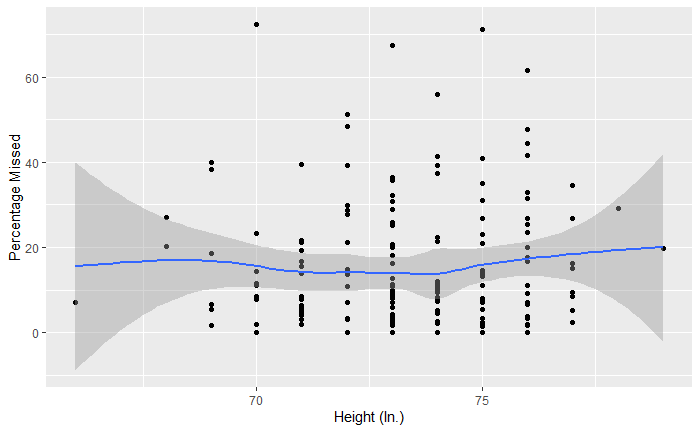
Looking at this graph, we can see that there isn’t a strong connection between increasing the height of a player and an increase in missed games. 0-1 with our predicting tools.
Weight
It shouldn’t come as a surprise that the more a person weighs, the more weight they are putting through their joints. Studies have shown that during walking, a person experiences three to four times their body weight of force through their knees. So a 200-pound player would be putting between 600 to 800 pounds of force through their knee with each step. During jogging, that number will increase to about twelve times body weight. So the same 200-pound player will have 2,400 pounds of force through their knee. Will that increased force lead to an increased likelihood of being injured?
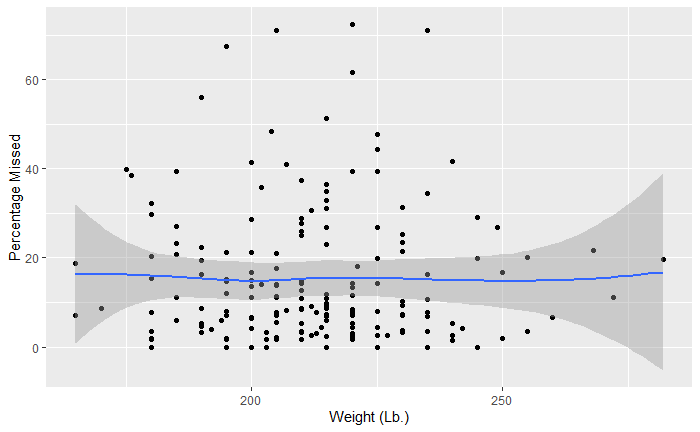
Once again, weight does not have a strong connection between the probability of being injured. This is a little easier to explain away than height. Weight is a factor in joint compression. And weight doesn’t play as big of a role in injuries as we once thought. Recent research has also shown that running and other high impact activities do not have detrimental effects that we once believed they did. Movement is good for our joints; as we move (running, cycling, lifting, you name it), it increases the fluid within our joints. The more fluid we have, the healthier our joints are.
Prince Fielder only missed 1 game from 2009 – 2013. He is a great example of how weight is not a good indicator of injury likelihood. We all remember, Fielder is a very large individual.
Weight also wouldn’t have as big of an impact on upper-body injuries. Gravity pushes us down, so weight will affect the ankles, knees, and hip joints more than the shoulder, elbow, wrist, and hand. All that being considered, it doesn’t surprise me that weight does not play a role in predicting injuries.
BMI
Height and weight alone don’t have a predictive value towards injuries. But could BMI? The best way to explain BMI is how weight is spread out over the body per inch. We know that height and weight separately don’t influence injury likelihood. But what if a player was really tall AND weighed a lot? Let’s look at Aaron Judge again. Really tall (6′ 8″) and weighs in at 282 pounds, according to Baseball-Reference. What do the numbers say?
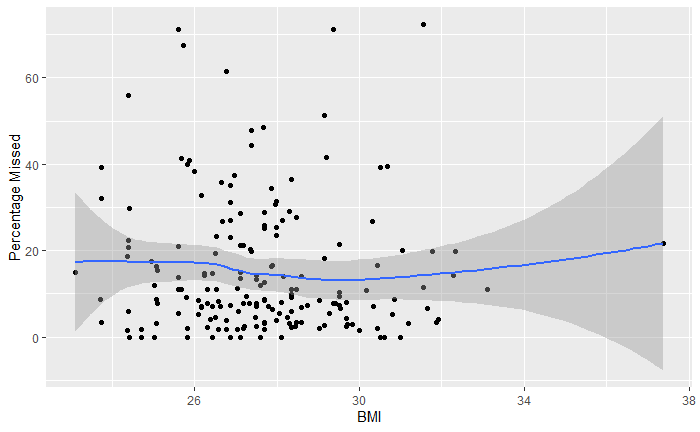
Once again, we see that BMI does not play a role in predicting injuries. By and large, these athletes are in good shape. Aaron Judge, while he could play on the Monstars, is a professional athlete. Other than the few examples like Pablo Sandoval and Miguel Sano, most of the hitters in the MLB look like athletes.
The issue with BMI as a health standard is highlighted in this graph. It is solely based on height and weight. The type of weight isn’t factored in. These players have the majority of their weight coming from muscle, and having a lot of muscle wouldn’t translate into being injured.
Position
This is a long shot, but hey, maybe it’ll work. Is it possible that playing a certain position will predispose you to be injured? Catchers have a lot of collisions and the position is viewed as being hard on their bodies. Outfielders have the wall and diving plays to worry about. You can find possible injury sources at every position. But if you had to guess, would playing a certain position increase your chance of being injured? Let’s take a look.
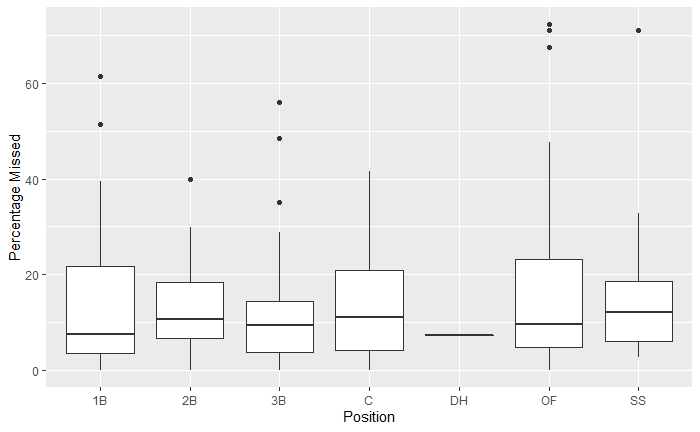
We can see that catcher and shortstop show to miss the most days on the IL. But we still don’t have a statistical correlation between positions and being injured. But what this does show me, is that the fear of drafting a catcher should be squashed. From a performance standpoint, yes catcher is a wasteland. But from an injury standpoint, they are not more likely than any other position to having an injury occur in any given year. The Posey rule has been a game-changer in taking steps to reduce potential injuries at home plate.
Age
Last and certainly not least, father time. The current line of thinking is that the older a player is, the more likely he will suffer from an injury. As we age, our bodies just start to break down. We don’t recover as quickly and hormone levels are dropping and a multitude of other factors lead to the aging process. With very few exceptions, we just don’t see guys playing into their late 30s early 40s. But does that mean older players are prone to be injured more often?
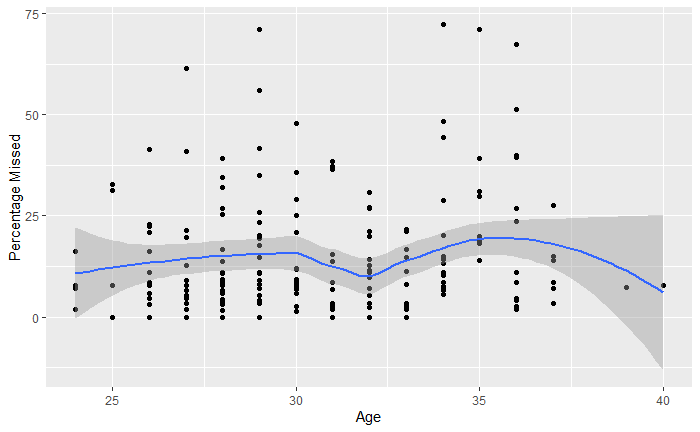
So what do we have here? This shows that every year a player ages, he is 0.64 times more likely to be on the IL. For example, a 33-year-old is expected to miss 6.4% more of the season than a 23-year-old. That will equal to 12 more days missed for the 33-year-old during that season. While this isn’t a revolutionary finding, it is a predictive tool that we can use. If your draft came down to 2 nearly identical players and one is younger, the numbers show to go with the younger player. Of course, this is talking about injuries in a vacuum. Injury history will play into this.
So while we didn’t find a way to predict injuries, we can build our team with the idea that position, height, and weight don’t play as big of a factor in injuries as I originally thought. Age does play a factor, albeit a small factor. So those guys who you think are injury-prone, we can say that it will only get worse as they age.
Predicting injuries is hard. Really hard. Genetics, weight training programs, diet, and a multitude of other factors make predicting injuries extremely difficult. Only having age as a predictive value was disappointing to find. But it is something that we can use when building our lineups.
Part 2 will cover specific hitters who we find on the IL more often than not. Just to tease the article a bit, let me know what you think! Is Giancarlo Stanton injury prone? Or has he just had some bad luck? We will take a dive into his injury history and come up with our determination.
Photos by Russell Lansford, Brian Rothmuller/Icon Sportswire | Adapted by J.R. Caines (@JRCainesDesign on Twitter and @caines_design on Instagram)
Graphics and analytical assistance by Paul Brendel.

Jake,
Has there been any studies that examined the correlation between player injuries in the minors and how injury-prone those same players have been once they become major league players? For pitchers there seems to be a relatively high correlation. But, what about position players?
Thanks
Hey Dave!
First off, thanks for reading the article! To answer your question… I haven’t seen anything. The source that I used to pull the injury data only had major league injuries and only went back to 2009 without including minor league information. I would agree with you that pitchers seem to have more of a correlation (depending on the injury of course!) but I’m hoping with what we have planned in parts 2 and 4 we are able to answer your question without having the minor league data.
-Jake
OK, thanks Jake!